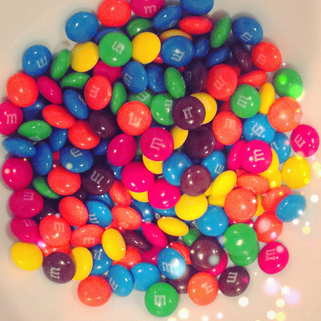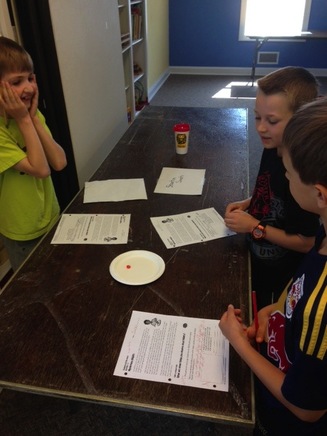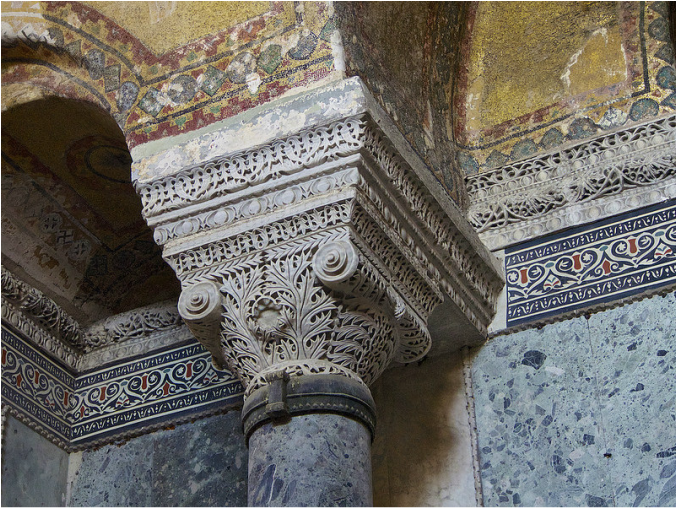|
with Kim Rodgers Sweet Test This week in Chemistry we focused on M&Ms. Yum! This was the first class in a series that will finish out our time together at Mosaic this year. The purpose is for the students to understand how to isolate a variable in a testing situation so that the results can be traced back to that variable. The students began by breaking into groups and observing an orange M&M using three of their five senses. We left out hearing and tasting. Then they broke open the M&M and described what they saw. We came back together in a group and shared our observations. Next, we looked at the question “What happens when an M&M is placed in water?” They followed a procedure in which they poured room-temperature water into a plastic plate until the bottom was covered with water. Then they placed the M&M in the center of the plate and observed for about a minute, keeping the water and M&M as still as possible. All of the groups noticed a small ring of color emanate from the M&M, with the circle expanding as time went on. Eventually the color completely came off the M&M and showed the brown chocolate center. We deduced that the water dissolves the sugar and color coating. This is a “property” of the M&M coating. Dealing with Variables We then discussed the variables involved in this experiment (the number of M&Ms, the color, the type of liquid the M&M was placed in, and the temperature of the water). Any of these variables can be changed to do entirely new experiments. We then brainstormed some questions to investigate over the next couple of weeks. Below are some of the questions:
Next week we will look at the color variable and construct an experiment that is designed to keep all variables the same except for the color of the M&M. Once the groups design an experiment that meets this criteria they will carry out their experiments and compare their results with other groups. The Turks Take OverThis week in the Middle Ages we learned about the fall of Constantinople. The Ottoman Turks were nomads who wandered to the west to avoid the Mongol armies. Trading with Muslim merchants, they heard the Koran read often and became Muslim themselves. They eventually settled near the edge of the Byzantine Empire and raised their young men to become ghazi, soldiers who were dedicated to conquering unbelievers and spreading Islam as their empire grew. Slowly the Byzantine Empire shrank. Only Constantinople was left to the Byzantine emperor. Mehmed the Conqueror became sultan of the Ottoman throne. He spent months pretending to be friendly with the Byzantine emperor, all the while planning to attack. He built a cannon so huge it had to be pulled by a hundred oxen. He also wanted to use gunpowder and had hired mercenaries to build his army. He approached the city with enough soldiers to outnumber the Byzantine soldiers twelve to one! The emperor refused to surrender so Mehmed fired his cannons multiple times against the wall. The walls crumbled slightly, but stood firm. Mehmed knew that the key to winning this battle was to attack from all sides. The problem was getting to the northern wall, which was only accessed by entering the Golden Horn, a harbor on the north side. The entrance was guarded by Byzantine warriors. The Turks solved that problem by hauling their warships out of the water and rolling them on dry land, passing the horrified onlookers behind the walls...70 ships! They dropped them into the harbor. Now they could attack from all sides. After two months food and water were scarce behind the walls. The Byzantine people had always said, “Constantinople won’t fall. Remember: the city is safe until the moon turns dark!” The moon shone brightly one night, but suddenly a shadow came slowly across it. The people thought this was a sure sign of disaster. It was actually an eclipse, but they didn’t know that at the time. The Ottoman Turks took their chance and threw themselves against the walls. Finally, one of the gates to the city was forced open and the Turks took over. Mehmed went straight to the Hagia Sophia and put his throne right in the middle of it, immediately having his soldiers transform it into a Muslim mosque. Sometimes the conquest of Constantinople is referred to as the end of the Middle Ages.
The Turks repaired the walls, laid new stones over the streets, and dug new wells. The Sultan of the Turks was becoming recognized as one of the most powerful rulers in the world. The greatest emperor of all was Suleiman the Lawgiver. Like Justinian, Suleiman gathered all the laws the Ottoman people had and put them together into one code the whole empire could follow. He chose governors who would supervise these laws and make sure the laws were followed. But he wanted to make sure the people were treated well, so sometimes he would dress in disguise and spy on his governors to see they were carrying out justice fairly. He had a spy network throughout the empire to do the same thing. He wanted the people to be safe and healthy. He also rebuilt the walls of Jerusalem after a dream warned him the city might be compromised. He placed statues of lions on either side of the gate to protect the city from intruders. Unfortunately his son inherited his throne after Suleiman died. He wasn’t as strong a ruler as his father, which led to the shrinking of the Ottoman Empire. It lasted for more than 300 years before it disappeared completely. Because cannons were used in the battle and hadn’t been seen before this attack, the students fashioned cannons out of tubes, rubber bands, paper clips, and plastic wrap. When they were done they used ping pong balls to shoot. This activity was a hit, needless to say. They had a fun time trying to make their ping pong ball go the farthest! We also dyed our shirts from last week with the beet juice. They will dry this week and be ready next Monday. Comments are closed.
|
Categories
All
Archives
May 2016
|


 RSS Feed
RSS Feed